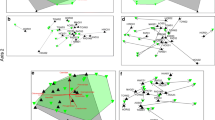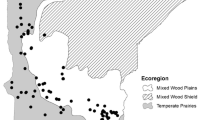Abstract
We developed a surface-associated activity trap (SAT) for sampling aquatic invertebrates in wetlands. We compared performance of this trap with that of a conventional activity trap (AT) based on nondetection rates and relative abundance estimates for 13 taxa of common wetland invertebrates and for taxon richness using data from experiments in constructed wetland. Taxon-specific non-detection rates for ATs generally exceeded those of SATs, and largest improvements using SATs were for Chironomidae and Gastropoda. SATs were efficient at capturing cladocera, Chironomidae, Gastropoda, total Crustacea, and multiple taxa (taxon richness) but were only slightly better than ATs at capturing Dytiscidae. Temporal differences in capture rates were observed only for cladocera, Chironomidae, Dytiscidae, and total Crustacea, with capture efficiencies of SATs usually decreasing from mid-June through mid-July for these taxa. We believe that SATs may be useful for characterizing wetland invertebrate communities and for developing improved measures of prey available to foraging waterfowl and other aquatic birds.
Similar content being viewed by others
Literature cited
Adamus, P. R. 1996. Bioindicators for assessing ecological integrity of prairie wetlands. Environmental Protection Agency, National Health and Environmental Effects Research Laboratory, Western Ecology Division. Corvallis, OR, USA. EPA/600/R-96/082. U.S.
Agresti, A. 1996. An Introduction to Categorical Data Analysis. John Wiley and Sons. New York, NY, USA.
Bartonek, J. C. and J. J. Hickey. 1969. Food habits of canvasbacks, redheads, and lesser scaup in Manitoba. Condor 71:280–290.
Bartonek, J. C. and H. W. Murdy. 1970. Summer foods of lesser scaup in subarctic taiga. Journal of the Arctic Institute of North America 23:35–44.
Bataille, K. J. and G. A. Baldassarre. 1993. Distribution and abundance of aquatic macroin vertebrates following drought in three prairie pothole wetlands. Wetlands 13:260–269.
Bouffard, S.H. and M.A. Hanson. 1997. Fish in waterfowl marshes waterfowl managers’ perspective. Wildlife Society Bulletin 25: 146–157.
Breslow, N.R. and D.G. Clayton. 1993. Approximate inference in generalized linear mixed models. Journal of the American Statistical Association 88:9–25.
Brinkman, M. A. and W. G. Duffy. 1996. Evaluation of four wetland aquatic invertebrate samplers and four sample sorting methods. Journal of Freshwater Ecology 11:193–200.
Chura, J. J. 1961. Food availability and preferences of juvenile mallards. North American Wildlife Conference Transactions 26:121–133.
Corkum, L. D. 1984. Movements of marsh-dwelling invertebrates. Freshwater Biology 14:89–94.
Cox, R. R., Jr., M. A. Hanson, C. C. Roy, N. H. Euliss, Jr., D. H. Johnson, and M. G. Butler. 1998. Mallard duckling growth and survival in relation to aquatic invertebrates. Journal of Wildlife Management 62:124–133.
Danell, K. and K. Sjöberg. 1980. Foods of Wigeon, teal, mallard and pintail during the summer in a Northern Swedish Lake. Viltrevy 11:141–167.
Elmberg, J., P. Nummi, H. Pöysa, and K. Sjöberg. 1992. Do intruding predators and trap position affect the reliability of catches in activity traps? Hydrobiologia 239:187–193.
Gerard, P. D., D. S. Smith, and G. Weerakkody. 1998. Limits of retrospective power analysis. Journal of Wildlife Management 62: 801–807.
Hanson, M. A., C. R. Roy, and K. D. Zimmer. 1995. Bait fish effects on wetland invertebrate communities and mallard ducklings-preliminary results and conclusions. p. 167–196. In B. Joselyn (ed.) Summaries of Wildlife Research Findings 1995. Minnesota Department of Natural Resources, Section of Wildlife, St. Paul, MN, USA.
Hanson, M. A. and M. R. Riggs 1995. Potential effects of fish predation on wetland invertebrates: a comparison of wetlands with and without fathead minnows. Wetlands 15:167–175.
Keene, O. N. 1995. The log transformation is special. Statistics in Medicine 14:811–819.
Kelsey, J., W. D. Thompson, and A. S. Evans. 1996. Methods in Observational Epidemiology. Oxford University Press. New York, NY, USA.
Krapu, G. L. and K. J. Reinecke. 1992. Foraging ecology and nutrition. p. 1–29. In B. D. Batt, A. D. Afton, M. G. Anderson, C. D. Ankney, D. H. Johnson, J. A. Kadlec, and G. L. Krapu (eds.) Ecology and Management of Breeding Waterfowl. University of Minnesota Press, Minneapolis, MN, USA.
Littell, R. C., G. A. Milliken, W. W. Stroup, and R. D. Wolfinger. 1996. SAS System for Mixed Models. SAS Institute Inc., Cary, NC, USA.
Manly, B. F. 1992. The Design and Analysis of Research Studies. Cambridge University Press, New York, NY, USA.
Merritt, R. W. and K. W. Cummins (eds.). 1984. An Introduction to the Aquatic Insects of North America. Kendall/Hunt Publishing Company, Dubuque, IA, USA.
Muller, K. and V. A. Benignus. 1992. Increasing scientific power with statistical power. Neurotoxicology and Teratology 14:211–219.
Murkin, H. R., P. G. Abbott, and J. A. Kadlec. 1983. A comparison of activity traps and sweep nets for sampling nektonic invertebrates in wetlands. Freshwater Invertebrate Biology 2:99–106.
Murkin, H. R. and D. A. Wrubleski. 1988. Aquatic invertebrates of freshwater wetlands: function and ecology. p. 239–249. In D. D. Hook, W. H. McKee, Jr., H. K. Smith, J. Gregory, V. G. Burrell, Jr., M. R. Devoe, R. E. Sojka, S. Gilbert, R. Banks, L. H. Stolzy, C. Brooks, T. D. Matthews, and T. H. Shear (eds.) The Ecology and Management of Wetlands. Volume 1: Ecology of Wetlands Croom Helm, London, England.
Pennak, R. W.. 1989. Freshwater Invertebrates of the United States: Protozoa to Mollusca. John Wiley and Sons, New York, NY, USA
Perret, N. G.. 1962. The spring and summer foods of the common mallard (Anas p. platyrhynchos L.) In south central Manitoba. M.S. Thesis. University of British Columbia. Vancouver, BC, Canada.
Resh, V. H. and J. K. Jackson. 1993. Rapid assessment approaches to biomonitoring using benthic macroinvertebrates. p. 195–233. In D. M. Rosenberg and V. H. Resh (eds.) Freshwater Biomonitoring and Benthic Macroinvertebrates. Chapman and Hall, New York, NY, USA.
Ringelman, J. K. and L. D. Flake. 1980. Diurnal visibility and activity of blue-winged teal and mallard broods. Journal of Wildlife Management 44:822–829.
Ross, L. C. and H. R. Murkin. 1989. Invertebrates. p. 35–38. In E. J. Murkin and H. R. Murkin (eds.) Marsh Ecology Research Program: Long-term Monitoring Procedures Manual. Delta Waterfowl and Wetlands Research Station, Portage la Prairie, MB, Canada.
Sjöberg, K. and K. Danell. 1982. Feeding activity of ducks in relation to diel emergence of chironomids. Canadian Journal of Zoology 60:1383–1387.
Stewart, R. E. and H. A. Kantrud. 1971. Classification of natural ponds and lakes in the glaciated prairie region. U.S. Fish and Wildlife Service, Washington, DC, USA. Resource Publication 92.
Sugden, L. G. 1973. Feeding ecology of pintail, gadwall, American widgeon, and lesser scaup ducklings. Canadian Wildlife Service Report Series 24. Ottawa, ON, Canada.
Swanson, G. A.. 1977. Diel food selection by Anatinae on a wastestabilization system. Journal of Wildlife Management 41:226–231.
Swanson, G. A. 1978. Funnel trap for collecting littoral macroinvertebrates. Progressive Fish-Culturist 40:73.
Swanson, G. A. and A. B. Sargeant. 1972. Observation of nighttime feeding behavior of ducks. Journal of Wildlife Management 36: 959–961.
Turner, A. M. and J. C. Trexler. 1997. Sampling aquatic invertebrates from marshes: evaluating the options. Journal of the North American Benthological Society 16:694–709.
Whitman, W.R. 1974. The response of macro-invertebrates to experimental marsh management. Ph.D. Thesis. University of Maine, Orono, ME, USA.
Author information
Authors and Affiliations
Rights and permissions
About this article
Cite this article
Hanson, M.A., Roy, C.C., Euliss, N.H. et al. A surface-associated activity trap for capturing water-surface and aquatic invertebrates in wetlands. Wetlands 20, 205–212 (2000). https://doi.org/10.1672/0277-5212(2000)020[0205:ASAATF]2.0.CO;2
Received:
Revised:
Accepted:
Issue Date:
DOI: https://doi.org/10.1672/0277-5212(2000)020[0205:ASAATF]2.0.CO;2




